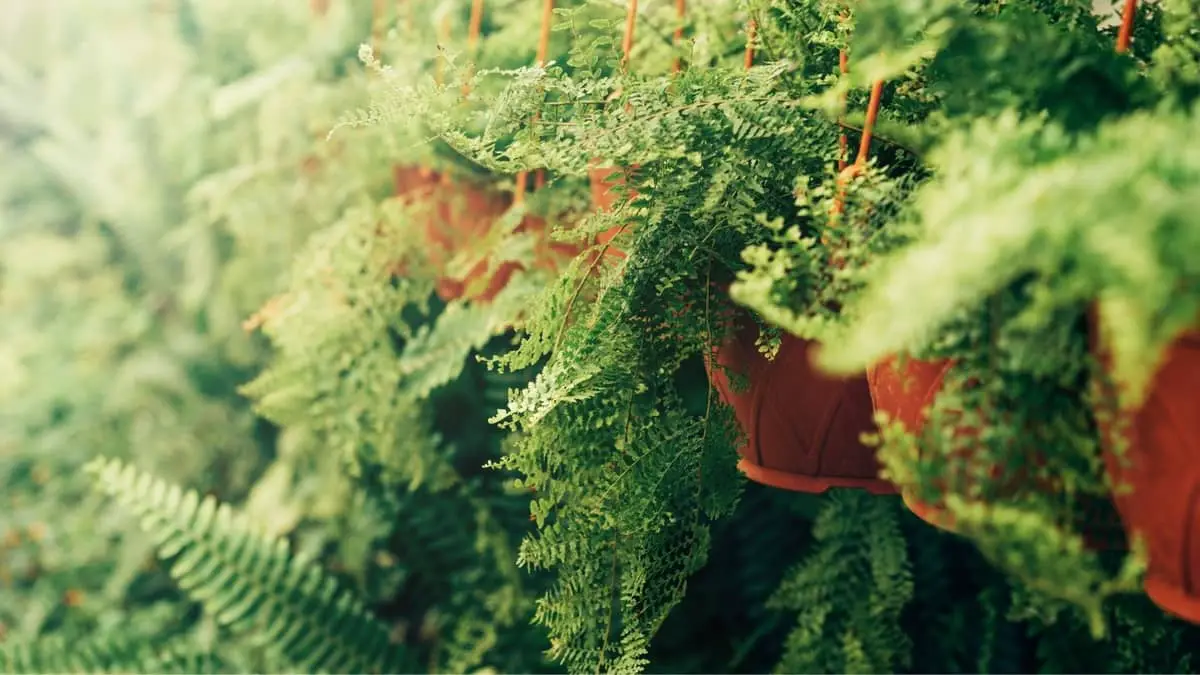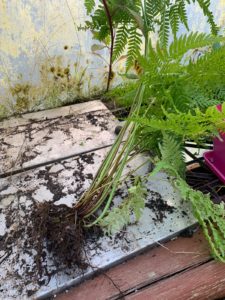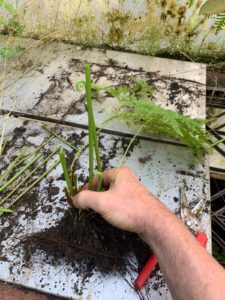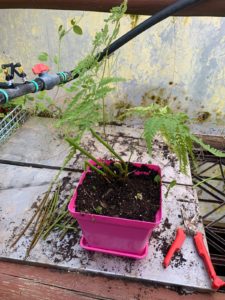Last Updated on August 11, 2022 by Cinthia
Ferns are a very broad and ancient group of plants and there is an incredibly diverse range of fern types out there. Some are giant tree ferns and others are small little things that grow a few inches tall. In most cases what you are calling a fern “root” is actually its stem or rhizome. Let us have a look at how ferns grow and how we can help them remain in their pots and do “fern stuff” where we want them to.
Ferns 101
It has been a really long time since I did Botany 101, so luckily the internet has evolved since then, and it was easy to catch up and refresh. I have been growing ferns since I was a little boy, and you sort of know all the stuff, but forget what some of the actual things are called.
Ferns are a primitive form of a plant. Fern leaves are called fronds, these connect to a stem called a rhizome and this rhizome has a few furry hairy little roots that anchor it to the ground and absorb some nutrients. This is rather different from a higher plant that has a lot more complexity in terms of its overall structure.
Ferns also produce stolons or runners. These are extensions that shoot out of the main rhizome and will then root and grow nearby. Again, it is really difficult to generalize too much about ferns because there are at least 10500 species of fern, and these things have an incredibly diverse range of growth patterns and tricks.
As a fern grows, the Rhizome gets longer in some cases. In the case of a tree fern, the rhizome can get really long – in the case of Cyathea australis up to an incredible 65 feet tall! A rhizome is normally a horizontal stem with a shoot on the end and from which side shoots can emerge, and roots grow downwards. A tree fern trunk is actually a confusing mass of roots that grows up. These are odd plants indeed.
What Do We Mean When We Ask About Fern “Roots” Growing Out Of The Pot?
Normally, when people ask about fern roots growing out of the pot it is more of a reference to the rhizome growing out of the pot. That is why the above sojourn into basic fern biology was important. It can also be a reference to stolons or runners coming out of the pot.
If we understand how the fern plant grows, we can also work out when and how to trim our ferns so that 1) they don’t grow out of the pot and 2) they don’t get killed by our trimming. Some ferns are indestructible and others are quite fiddly and die easily.
My experience of ferns, in general, is that they need to be repotted quite often. This is because they are shallow-rooted, and repotting them allows us to give them more fresh soil. It also means that one potted fern can become three potted ferns. This means that you keep having more ferns, and can start giving them away as gifts! My next project is to set up a fern wall. I have seen these on the paradise island of Mauritius and they are just amazing.
Learn more about: How To Care For Ferns In Hanging Baskets
How To Make Soil For Ferns
A while back you could order pretty much any premix soil for specialist plants online. The world seems to have fallen apart a bit and now you are going to have to mix your own! I normally actually do this, so I just take one part of good potting soil such as this, and then I mix that with the second part of coconut coir (after hydrating it as per the instructions on the block).
Once this is mixed I then mix in some finely milled pine bark. You can also mix in a few teaspoons of coffee grounds if you have them, and some old tea bags will never hurt either.
Break the tea bags open because teabags are now in some sort of plastic bag sadly. Give it all a good swirl and there you have it! Fancy fern soil.
How Do We Control Our Ferns?
Option One: Be A Dinosaur and Savage The Fern, Or Even Burn It!!
Cut parts of the plant off that you do not like – you can be quite brutal in most cases. If roots, rhizomes, or stolons come out of the pot, cut them off and throw them away. These plants were around in the time of the dinosaurs and survived being nibbled by various titanosaurs that must have eaten a lot because they weighed over 80 tons. I find that with most of my ferns a bit of tough love, timing the fronds right down, and just brutalizing the rhizomes never hurts. I have one fern that does not like this sort of treatment. Google the name of your specific fern and find out if it is a tough fern.
I actually had one fern that was doing really badly and a friend of mine said “cover it in newspaper and set it alight”. I did this and the fern was burnt to a crisp. Two weeks later it emerged from the ground in unfurling glory and now I burn it yearly!!
I love these ferns. I actually have no idea what they are, but they come up like weeds in my greenhouse. I transplant them into pots and use them as house plants. They grow from rhizomes in the greenhouse. Here I have one rhizome that I have cut away from the mother plant (left). The middle picture shows how I remove most of the fronds and then plant them in the pot. Within a month this will be a huge bushy fern that will then go into the house and survive about three weeks until my cat eats it.
Option 2: Multiply Your Fern
You can empty the pot, and then just break up the clumps of ferns and cut them into smaller individual plants. Trim off the large fronds and then replant the trimmed ferns in new pots with new fern soil as per the mixing instructions above.
Keep the transplanted ferns moist and in a bit of shade for a few days then move them back to the normal place where the parent plant was. You should have a high success rate!
I hope this article has helped you understand the anatomy of ferns and how we can work with them to keep our ferns healthy, multiplying and beautiful. Ferns are crazy things and now you know how to deal with fern roots growing out of the pot. I have enjoyed growing these almost useless (most of them are inedible) plants for decades and I find they give me joy by filtering the air at least. If you enjoyed this please share.
FAQs
Do ferns outgrow their pots?
Most species will with time do so. You can then remove them from the pot, divide them into clumps and replant them in new pots. This helps you multiply your ferns and keep them looking their best. Repotting them gives you a chance to give them fresh soil. Ferns have reasonably pathetic roots and they run into nutrient deficiencies in pots quite easily.
What do you do with fern roots?
Normally you can plant them in new pots and they will yield new ferns. You can keep these or give them away. Alternatively, after you cut them off throw them in the trash. Fern roots are really fern rhizomes and will give rise to new ferns if planted. Some ferns are fussy and will not transplant easily, but most ferns that make it to our houses are tough species.
Can you trim the roots of a fern?
Yes. In many cases what you think is a root is actually a piece of the rhizome or a stolen. Either can be removed and planted to yield a new fern. The actual roots are small fibrous things that you can cut off should you so wish - work in moderation and watch your plant and learn what it likes.
Do ferns need a lot of root space?
This will depend on the fern! Choose a fern that suits your space. There are 10500 species which range from being about 2 inches tall to giant tree ferns that tower four stories high! There is a fern for every space on earth, be it a small little fern to grow in the corner next to your bonsai, or a tree fern that you want to watch lean over your house as you grow old with it.
Dr. Garth A. Cambray is a Canadian/South African entrepreneur and beekeeper with 28 years of experience in apiculture and specializes in adding value to honey. His Ph.D. research developed a new advanced continuous fermentation method for making mead that has resulted in a number of companies globally being able to access markets for mead. His company, Makana Meadery, exports honey mead to the USA where it is available to discerning connoisseurs. He has also developed technologies to commercially manufacture organic honey vinegar in Zambia for export globally. He holds a few patents globally in the ethanol industry and believes in technology and knowledge transfer for human development and environmental sustainability. One of his proudest achievements is the fact that the wind farm he started at one of his old apiary sites has essentially made his hometown carbon neutral.







